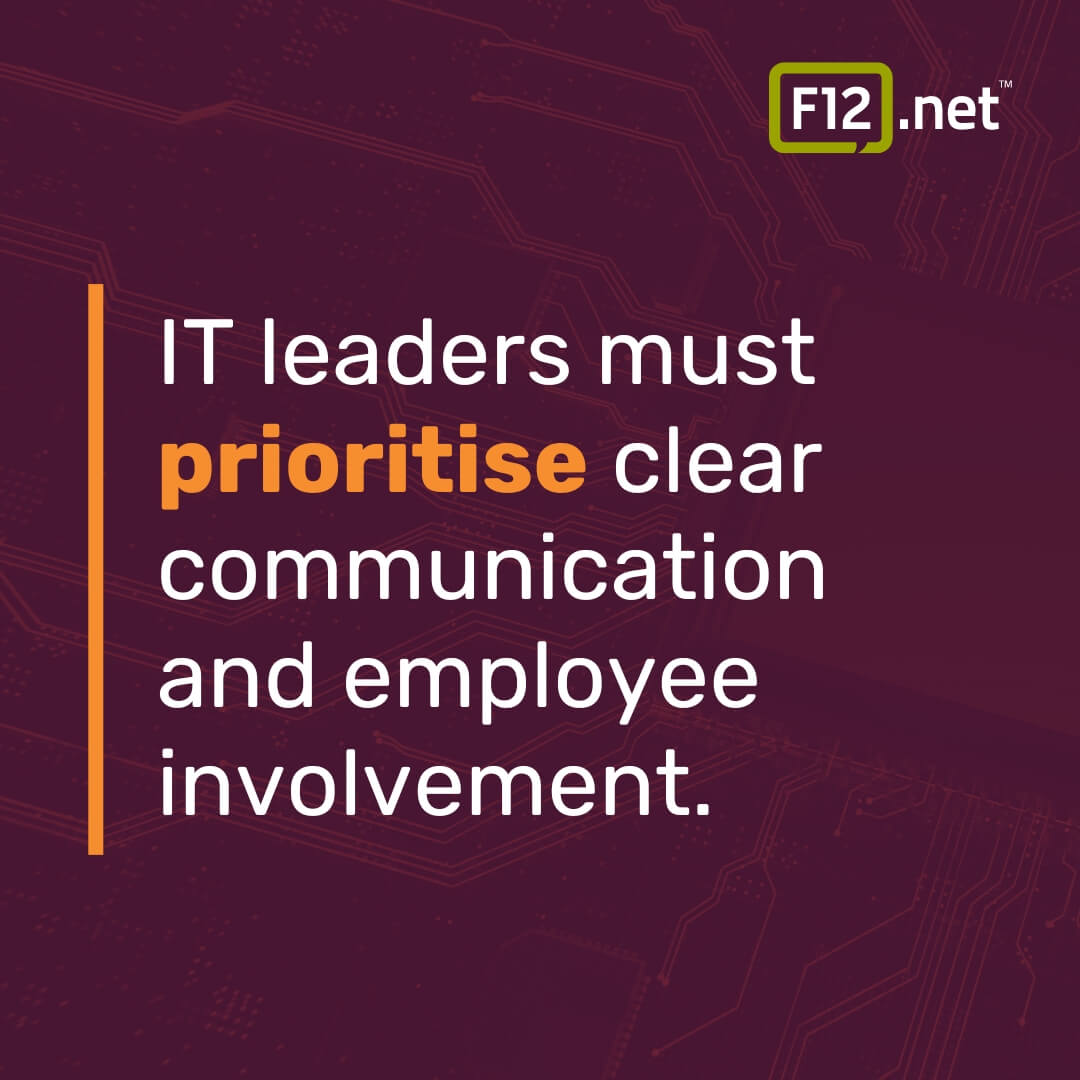Brief: In this article, we explore 15 practical Digital Transformation Strategies for IT leaders. Explore how addressing resistance to change, creating a comprehensive roadmap, and implementing best practices can drive successful digital transformation in your organisation.
“ What’s the point of learning how to transform if we can’t do it under fire?” – Black Arachnia: Beast Machines: Transformers
The quote from Black Arachnia resonates deeply with the challenges faced by IT leaders.
Just as the characters in “Beast Machines: Transformers” must adapt and transform under pressure, businesses today are at a critical juncture in their digital transformation journeys.
The challenges are real: resistance to change, organisational silos, and a changing technology environment.
But why does this matter?
It’s simple: those who adapt and use these technologies will thrive, while those who don’t may struggle to stay relevant.
Consider the advantage that companies like Amazon and Netflix have gained by embracing digital technologies.
They’ve changed their industries, setting new standards for customer experience and operational efficiency.
A study by Forbes highlights that 70% of companies failing to adopt digital transformation may cease to exist within five years.

In this context, businesses must align digital initiatives with business goals, create collaboration across departments, and continuously evolve to meet market and customer demands.
Successful digital transformation requires a proactive approach, where leaders actively drive innovation and build resilient, future-ready organisations.
In this article, we’ll explore 15 practical, actionable strategies to help you address digital transformation and lead in this new era.
From developing a comprehensive roadmap to building a culture of innovation, these proven tactics will equip you with the tools you need to drive meaningful change and achieve your digital transformation goals.
Get ready to take your IT leadership to the next level. Let’s get started.
Digital Transformation Challenges: Overcoming Resistance to Change
- Tackle employee resistance through clear communication and involvement
- Break down organisational silos with collaboration and shared goals
- Address skill gaps with targeted training and support for employees
Digital transformation can be a challenging process for many organisations, especially when it comes to overcoming resistance to change.
IT leaders must overcome various challenges to ensure a smooth and successful transition. Let’s explore some practical strategies to address these hurdles.
Addressing Employee Resistance
One of the primary challenges in digital transformation is employee resistance.
People are often hesitant to embrace new technologies and processes, fearing job loss or struggling to adapt to unfamiliar tools. To overcome this obstacle, IT leaders must prioritise clear communication and employee involvement.

Communicate the Benefits Clearly
When introducing digital transformation initiatives, it’s crucial to articulate the benefits for both the organisation and individual employees.
Explain how new technologies will streamline processes, increase efficiency, and enable employees to focus on higher-value tasks. Highlight success stories from other companies or departments that have undergone similar changes.
Involve Employees in the Process
Engage employees from the start by seeking their input and feedback.
Conduct surveys, focus groups, or workshops to gather insights into their concerns and suggestions. Involving employees in the decision-making process instills a sense of ownership and reduces resistance.
Identify digital transformation champions within each department who can act as advocates and support their colleagues during the transition. These champions can provide valuable insights into the unique needs and challenges of their teams.
Provide Training and Support
Invest in comprehensive training programs to help employees acquire the necessary skills to thrive in the new digital environment. Offer a mix of in-person workshops, online courses, and hands-on training sessions to cater to different learning styles.
Establish a dedicated support team or helpdesk to address any questions or issues employees may encounter during the transition. Ensure that support resources are easily accessible and responsive to minimise frustration and maintain productivity.
Overcoming Organisational Silos
Another significant challenge in digital transformation is breaking down organisational silos.
Silos hinder collaboration, lead to duplicated efforts, and impede the flow of information. To overcome this hurdle, IT leaders must make a culture of collaboration and establish shared goals.
Encourage Cross-Functional collaboration
Promote cross-functional collaboration by creating opportunities for employees from different departments to work together on digital transformation projects. Establish cross-functional teams that bring together diverse skill sets and perspectives to tackle complex challenges.
Implement collaboration tools and platforms that facilitate seamless communication and information sharing across departments. Encourage the use of shared workspaces, such as cloud-based documents and project management tools, this improves your team’s cloud skills.
Establish a Shared Vision and Goals
Develop a clear and compelling vision for digital transformation that aligns with the organisation’s overall strategy. Communicate this vision to all employees, emphasising how it contributes to the company’s success and individual growth opportunities.
Set specific, measurable, and achievable goals for each department and team, ensuring they align with the overall digital transformation objectives. Regularly review progress and celebrate milestones to maintain momentum and motivation.
Break Down Silos through Process Redesign
Identify processes that span multiple departments and redesign them to eliminate silos and improve efficiency. Use technology to automate workflows, reduce manual handoffs, and enable seamless data flow between systems.
Encourage IT leaders to work closely with business process owners to identify bottlenecks, redundancies, and opportunities for improvement. By streamlining processes and eliminating silos, organisations can unlock the full potential of digital transformation.
Addressing Skill Gaps
As digital transformation introduces new technologies and processes, employees may face skill gaps that hinder their ability to adapt and perform effectively. IT leaders must proactively address these skill gaps to ensure a successful transition.
Assess Current Skills and Identify Gaps
Conduct a thorough assessment of the current skills within the organisation and identify areas where employees may lack the necessary expertise to thrive in the new digital environment. This assessment can include surveys, interviews, or performance evaluations.
Provide Targeted Training and Development
Based on the identified skill gaps, develop targeted training and development programmes to equip employees with the knowledge and skills they need. This may include technical training on specific tools and platforms, as well as soft skills training on collaboration, communication, and problem-solving.
Partner with external training providers or educational institutions to offer specialised courses or certifications aligned with the organisation’s digital transformation goals. Encourage employees to take advantage of these learning opportunities and provide incentives for skill acquisition.
Make a Culture of Continuous Learning
Cultivate a culture that values continuous learning and encourages employees to take ownership of their professional development. Provide resources and support for self-directed learning, such as access to online courses, webinars, and industry events.
Encourage knowledge sharing among employees through mentorship programmes, lunch-and-learn sessions, or internal forums where employees can share their expertise and learn from one another.
Celebrating and rewarding employees who actively engage in learning and skill development can reinforce the importance of continuous growth.
By addressing employee resistance, breaking down organisational silos, and closing skill gaps, IT leaders can beat the challenges of digital transformation and set their organisations up for success.
Digital Transformation Roadmap: A Step-by-Step Guide for IT Leaders
- Break down the digital transformation process into manageable steps
- Ensure alignment with business goals and measure progress regularly
- Create a culture of continuous improvement and adaptability
Step 1: Assess Current State and Set Goals
It’s crucial to evaluate your organisation’s current technology infrastructure and capabilities. This assessment will help identify areas for improvement and set the foundation for establishing measurable goals.
Start by conducting a thorough audit of your existing systems, applications, and processes. Engage with key stakeholders across various departments to gather insights on pain points, inefficiencies, and potential opportunities for digitisation.
This collaborative approach will ensure that your digital transformation objectives align with the overall business strategy and address the needs of your entire organisation.
Once you have a clear understanding of your current state, define specific, measurable, achievable, relevant, and time-bound (SMART) goals for your digital transformation initiative.
These goals should be directly tied to business outcomes, such as improving operational efficiency, improving customer experience, or driving revenue growth.
Key Actions:
- Conduct a comprehensive technology audit
- Engage with stakeholders to identify pain points and opportunities
- Define SMART goals aligned with business objectives
Step 2: Develop a Comprehensive Plan
With your goals clearly defined, the next step is to develop a comprehensive plan that outlines the initiatives, timelines, and resources required to achieve your digital transformation objectives.
Start by prioritising initiatives based on their impact and feasibility. Consider factors such as the potential return on investment, the complexity of implementation, and the resources required.
This prioritisation will help you focus your efforts on the most critical and impactful initiatives first.
Next, create a detailed timeline and budget for each initiative. Break down the implementation process into smaller, manageable tasks and assign clear roles and responsibilities to ensure accountability.
Consider the interdependencies between initiatives and allocate resources accordingly to avoid bottlenecks and ensure smooth execution.
Key Actions:
- Prioritise initiatives based on impact and feasibility
- Create a detailed timeline and budget for each initiative
- Assign roles and responsibilities to ensure accountability
Step 3: Implement and Monitor Progress
With your comprehensive plan in place, it’s time to execute your digital transformation initiatives. Implement the plan in phases, starting with the high-impact initiatives identified during the prioritisation process.
As you implement each initiative, establish clear metrics and key performance indicators (KPIs) to monitor progress and measure success. Regularly review these metrics and adjust your plan as needed to ensure you stay on track towards achieving your goals.
Celebrate successes along the way and openly communicate progress to stakeholders. This transparency will help maintain momentum and make a culture of continuous improvement. At the same time, be prepared to learn from setbacks and adapt your approach as necessary.
Digital transformation is an iterative process, and embracing a mindset of agility and adaptability is key to long-term success.
Key Actions:
- Execute the plan in phases, starting with high-impact initiatives
- Establish clear metrics and KPIs to monitor progress
- Celebrate successes and learn from setbacks
Step 4: Creating a Culture of Continuous Improvement
Digital transformation is not a one-time event but an ongoing journey. To truly embed digital capabilities into your organisation’s DNA, it’s essential to create a culture of continuous improvement and adaptability.
Encourage experimentation and innovation at all levels of the organisation. Create opportunities for employees to share ideas, collaborate across departments, and contribute to the digital transformation effort.
Provide training and resources to help your team develop the skills and mindset needed to thrive in a digitally-driven environment.
Regularly review and refine your digital transformation roadmap based on feedback, market trends, and emerging technologies. Stay attuned to the evolving needs of your customers and be prepared to pivot your strategy as necessary to remain competitive.
Key Actions:
- Encourage experimentation and innovation at all levels
- Provide training and resources to support digital skill development
- Regularly review and refine the digital transformation roadmap
By following this step-by-step guide and making a culture of continuous improvement, IT leaders can successfully complete the complex process of digital transformation and drive meaningful, lasting change within their organisations.
Digital Transformation Best Practices: Proven Strategies for Success
- Prioritise customer needs and use data to drive decision-making
- Have a culture of innovation and experimentation
- Invest in talent development and upskilling for long-term success
Embrace a Customer-Centric Approach
Putting the customer at the centre of digital transformation efforts is crucial for success. This means prioritising customer needs and preferences when making technology decisions. Use data analytics to gain deep insights into customer behaviour, preferences, and pain points.
This data-driven approach helps inform product development, service improvements, and overall business strategy.
Continuously gather customer feedback through surveys, interviews, and other channels.
Actively listen to their concerns and suggestions, and use these insights to iterate and improve. By involving customers in the digital transformation process, companies can ensure they are delivering value and meeting evolving expectations.
Prioritise Customer Needs and Preferences in Technology Decisions
When evaluating new technologies or digital solutions, always consider how they will impact the customer experience.
Will they make processes faster, easier, or more convenient for customers? Will they address specific pain points or challenges customers face?
Prioritising customer needs helps ensure that digital investments are aligned with business goals and deliver tangible benefits.
Use Data Analytics to Gain Insights into Customer Behaviour and Preferences
Data is a powerful tool for understanding customers and making informed decisions. Use data analytics to identify patterns, trends, and insights into customer behaviour.
This can include analysing website traffic, customer purchase history, social media interactions, and more. Use these insights to segment customers, personalise experiences, and optimise marketing efforts.
For instance, companies like Mastercard have successfully utilised data analytics to improve customer experiences and improve business outcomes.
Continuously Gather Customer Feedback and Iterate Based on Insights
Regularly seek out customer feedback to stay attuned to their needs and preferences. Conduct surveys, focus groups, and user testing to gather input on products, services, and digital experiences.
Use this feedback to identify areas for improvement and prioritise changes based on customer impact.
Establish processes for acting on customer feedback and communicating updates back to customers. This helps build trust and shows customers that their input is valued and being used to drive meaningful change.
Making a Culture of Innovation
Creating a culture that encourages innovation and experimentation is essential for successful digital transformation. This means providing employees with the resources, support, and freedom to explore new ideas and take calculated risks.
Encourage employees to think creatively and challenge the status quo. Create opportunities for cross-functional collaboration and idea sharing, such as hackathons or innovation workshops. Provide training and resources to help employees develop new skills and stay up-to-date with emerging technologies.
Encourage Experimentation and Risk-Taking Within the Organisation
Give employees the autonomy to experiment with new approaches and technologies. Encourage a “fail fast” mentality, where teams can quickly test ideas, learn from failures, and iterate based on feedback.
Celebrate and reward innovative thinking, even if experiments don’t always lead to successful outcomes.
Establish an innovation budget or incubator programme to support employee-driven projects and initiatives. This shows a commitment to innovation and empowers employees to drive change from the ground up.
For example, companies like UL Solutions have successfully implemented innovation programmes to drive growth and innovation.
Provide Resources and Support for Employee Innovation
Offer training and resources to help employees develop new skills and stay up-to-date with emerging technologies.
This can include online courses, workshops, mentorship programmes, and more. Focus on developing both technical skills (e.g. data analytics, cloud computing) and soft skills (e.g. adaptability, collaboration) that are essential for exploring change.
Invest in Talent and Skills Development
As technology evolves, so too must the skills and capabilities of the workforce. Investing in talent development is critical for long-term success with digital transformation.
Identify skills gaps within the organisation and provide training opportunities to help employees upskill and reskill. This can include online courses, workshops, mentorship programmes, and more.
Focus on developing both technical skills (e.g. data analytics, cloud computing) and soft skills (e.g. adaptability, collaboration) that are essential for exploring change.
Identify Skills Gaps and Provide Training Opportunities for Employees
Conduct a skills assessment to identify areas where employees may need additional training or support. Work with HR and department leaders to develop targeted training programmes that align with business goals and digital transformation priorities.
Offer a mix of formal training (e.g. certification courses) and informal learning opportunities (e.g. lunch and learns, job shadowing). Encourage employees to take ownership of their own learning and development by providing resources and incentives for continuous upskilling.
Attract and Retain Top Talent with Digital Expertise
In addition to upskilling existing employees, it’s important to attract and retain top talent with specialised digital skills. This may require rethinking traditional hiring practices and job descriptions to appeal to a new generation of tech-savvy workers.
Highlight the organisation’s commitment to innovation and digital transformation in job postings and employer branding materials.
Offer competitive compensation packages and benefits that are attractive to digital talent, such as flexible work arrangements or opportunities for career advancement.
Encourage Continuous Learning and Upskilling Across the Organisation
Make continuous learning a core part of the company culture. Encourage employees to set learning goals and provide support for achieving them. Celebrate and recognise employees who take initiative to develop new skills and share knowledge with others.
Having a growth mindset across the organisation, where employees feel empowered to take on new challenges and learn from failures.
Encourage managers to have regular career development conversations with their teams and provide opportunities for stretch assignments and cross-functional projects.
By embracing a customer-centric approach, creating a culture of innovation, and investing in talent development, IT leaders can set their organisations up for success with digital transformation.
Digital Transformation Success Factors: Key Enablers of Change
- Effective leadership, agile approach, and powerful technology infrastructure are critical for digital transformation success
- Overcoming resistance to change and ensuring seamless integration of new technologies are key challenges
- Investing in the right talent, creating a culture of innovation, and utilising data analytics are essential enablers for success.
Digital transformation is about adopting new technologies and requires a fundamental shift in mindset, culture, and leadership. IT leaders must focus on key success factors that enable smooth transitions and drive meaningful change.
Strong Leadership and Vision
Effective leadership is the cornerstone of successful digital transformation. IT leaders must establish a clear and compelling vision that aligns with the organisation’s strategic goals.
This vision should be communicated effectively to all stakeholders, ensuring buy-in and commitment across the board.
According to a study by McKinsey & Company, 70% of digital transformations fail, largely due to a lack of leadership support and poor communication of the digital strategy.

Leaders must lead by example, demonstrating their commitment to the transformation process. They should actively engage with teams, encouraging open communication and making a culture of collaboration.
Overcoming Resistance to Change
One of the biggest challenges IT leaders face during digital transformation is resistance to change. Employees may feel threatened by new technologies or fear that their roles will become obsolete.
To overcome this hurdle, leaders must:
- Communicate the benefits of digital transformation clearly and consistently
- Involve employees in the change process, seeking their input and feedback
- Provide training and support to help employees adapt to new tools and processes
Agile and Flexible Approach
Agility and flexibility are essential for successful digital transformation. IT leaders must adopt agile methodologies that allow teams to respond quickly to changing needs and market demands.
Embracing a mindset of continuous improvement and iteration is crucial. Teams should be encouraged to experiment, learn from failures, and adapt their approaches based on feedback and insights.
According to a report by Capstera, Agile organisations are more likely to achieve 30% higher profits and 37% faster revenue growth than their non-agile counterparts.
Powerful Technology Infrastructure
Investing in a scalable and secure technology infrastructure is a critical success factor for digital transformation. IT leaders must ensure that new technologies integrate seamlessly with existing systems, minimising disruptions and maximising efficiency.
Data management and analytics capabilities should be prioritised, as data-driven insights are essential for informed decision-making and continuous improvement.
According to a survey by Forbes, 91.6% of executives report that the pace of investment in Big Data and AI is accelerating.
Ensuring Seamless Integration
One of the key challenges IT leaders face when implementing digital technologies is ensuring seamless integration with existing systems and processes.
To overcome this challenge, leaders should:
- Conduct thorough assessments of current technologies and identify potential integration points
- collaborate closely with vendors and partners to ensure smooth implementations
- Allocate sufficient resources and budget for integration efforts
By focusing on these key success factors and enablers of change, IT leaders can find the challenges of digital transformation and drive meaningful, lasting impact within their organisations.
What is Digital Transformation?
TL;DR:
- Digital transformation integrates digital tech into all business areas
- Improves efficiency, customer experience, and adaptability
- Requires changes in technology, processes, and culture
Definition and Scope
Digital transformation is the process of integrating digital technology into all areas of a business, fundamentally changing how it operates and delivers value to customers.
It’s about adopting new technologies and transforming processes, culture, and the way an organisation thinks and works.
The scope of digital transformation is broad, encompassing various aspects of a business:
- Technology: Adopting new digital tools, platforms, and systems to modernise and streamline operations
- Processes: Redesigning and optimising workflows to use digital capabilities and improve efficiency
- Culture: Creating a mindset of innovation, collaboration, and continuous improvement
Examples of Digital Transformation Initiatives
Some common examples of digital transformation initiatives include:
- Moving to cloud-based infrastructure and services
- Implementing automation and artificial intelligence to streamline processes
- Developing mobile and web applications to improve customer engagement
- Using data analytics to gain insights and make data-driven decisions
Benefits of Digital Transformation
Digital transformation offers numerous benefits to organisations that embrace it:
- Improved efficiency and productivity: By automating manual tasks and streamlining processes, businesses can reduce costs, minimise errors, and free up employees to focus on higher-value activities. According to a study by McKinsey, companies that successfully implement digital transformation can see a 20-30% increase in productivity.
- Improved customer experience: Digital technologies enable businesses to provide personalised, seamless, and convenient interactions across multiple channels. This can lead to increased customer satisfaction, loyalty, and advocacy. A study by McKinsey found that companies with a customer-centric approach to digital transformation see a 20-30% increase in customer satisfaction metrics.
- Increased agility and adaptability: Digital transformation enables businesses to quickly respond to changing market conditions, customer needs, and competitive pressures. By using cloud-based infrastructure and agile development methodologies, organisations can develop and deploy new products, services, and features.

The Importance of Data in Digital Transformation
Data plays a crucial role in digital transformation. By collecting, analysing, and using data from various sources, businesses can gain valuable insights into customer behavior, market trends, and operational performance.
This data-driven approach enables organisations to make informed decisions, optimise processes, and create personalised experiences for customers.
However, to fully harness the power of data, businesses need to have the right infrastructure, tools, and skills in place.
This includes:
- Implementing data governance and security strategies to ensure data quality, consistency, and protection
- Investing in data analytics platforms and tools to process and visualise large volumes of data
- Building a data-driven culture that values insights and encourages data-based decision-making
By understanding the definition, scope, and benefits of digital transformation, IT leaders can better guide their organisations through this transformative journey. However, the path to digital transformation is not without its challenges, which we’ll explore in the next section.
Common Digital Transformation Challenges
- Digital transformation is a complex process that requires significant resources, skills, and organisational change
- Legacy systems, lack of expertise, and resistance to change are among the top challenges faced by organisations
- Overcoming these challenges requires a strategic approach, investment in technology and talent, and a culture of innovation
Legacy Systems and Technical Debt
One of the biggest obstacles to digital transformation is the presence of outdated technology and legacy systems. Many organisations have accumulated significant technical debt over the years, with systems that are difficult to maintain, integrate, and scale.
These legacy systems can hinder the adoption of new technologies and limit an organisation’s ability to innovate and respond to changing market demands.
To address this challenge, IT leaders must develop strategies for modernising legacy systems and reducing technical debt. This may involve a phased approach, where critical systems are prioritised for upgrades or replacement, while less essential systems are gradually phased out.
It’s important to assess the business value and risk associated with each system, and develop a roadmap that aligns with the organisation’s overall digital transformation goals.
Strategies for Modernising Legacy Systems
- Conduct a thorough assessment of existing systems to identify areas of technical debt and prioritise modernisation efforts based on business value and risk.
- Consider a phased approach to modernisation, focusing on critical systems first and gradually phasing out less essential systems.
- Explore options for integrating legacy systems with new technologies, such as APIs or middleware, to extend their functionality and lifespan.
- Invest in training and upskilling IT staff to ensure they have the necessary skills to support modernisation efforts and maintain new systems.
Lack of Skills and Expertise
Another significant challenge in digital transformation is the skills gap in emerging technologies such as artificial intelligence, machine learning, and blockchain.
Many organisations struggle to find and retain talent with the necessary skills to implement and maintain these technologies, which can delay or derail transformation initiatives.
To bridge this gap, organisations must invest in employee training and development programmes to upskill existing staff and build internal expertise.
This may involve partnering with educational institutions, online learning platforms, or industry associations to provide access to relevant courses and certifications. Additionally, organisations may need to recruit new talent with specialised skills to supplement their existing workforce.
Investing in Employee Training and Talent Acquisition
- Identify the specific skills and expertise required to support digital transformation initiatives, and assess the current skill levels of existing staff.
- Develop a comprehensive training and development programme that includes both technical and soft skills, such as change management and collaboration.
- Partner with educational institutions, online learning platforms, or industry associations to provide access to relevant courses and certifications.
- Recruit new talent with specialised skills to supplement existing workforce, and consider offering competitive compensation and benefits packages to attract top talent.
Resistance to Change
Digital transformation often requires significant changes to organisational culture, processes, and ways of working, which can be met with resistance from employees and stakeholders.
This resistance can stem from fear of job loss, lack of understanding of the benefits of digital transformation, or simply a preference for the status quo.
To overcome this challenge, IT leaders must work closely with business leaders and HR to develop a change management strategy that addresses the concerns and needs of employees.
This may involve clear communication about the goals and benefits of digital transformation, as well as providing training and support to help employees adapt to new technologies and ways of working.
Strategies for Overcoming Resistance to Change
- Develop a clear and compelling vision for digital transformation that aligns with the organisation’s overall strategy and goals.
- Communicate the vision and benefits of digital transformation to all stakeholders, including employees, customers, and partners.
- Engage employees in the transformation process through workshops, feedback sessions, and other participatory activities.
- Provide training and support to help employees adapt to new technologies and ways of working, and celebrate successes along the way.
Lack of Executive Buy-In
Digital transformation requires significant investment and organisational change, which can be difficult to secure without the support and commitment of executive leadership.
IT leaders must be able to articulate the business value and strategic importance of digital transformation to gain the necessary support and resources.
To gain executive buy-in, IT leaders must develop a strong business case for digital transformation that demonstrates the potential benefits and return on investment.
This may involve conducting pilot projects or proof-of-concepts to demonstrate the value of new technologies, as well as benchmarking against industry peers and competitors.
Building a Strong Business Case for Digital Transformation
- Identify the specific business problems or opportunities that digital transformation can address, and quantify the potential benefits in terms of cost savings, revenue growth, or improved customer experience.
- Conduct pilot projects or proof-of-concepts to demonstrate the value of new technologies and validate assumptions.
- Benchmark against industry peers and competitors to show how digital transformation can help the organisation stay competitive and relevant.
- Develop a clear and compelling business case that articulates the strategic importance of digital transformation and the potential return on investment.
Integration and Interoperability Issues
Digital transformation often involves the adoption of new technologies and platforms that need to be integrated with existing systems and processes.
This can be a complex and time-consuming process, particularly when dealing with legacy systems or disparate data sources.
To address this challenge, IT leaders must develop a comprehensive integration strategy that considers the entire technology ecosystem, including both internal and external systems.
This may involve adopting standardised protocols and interfaces, such as APIs or microservices, to enable seamless integration and interoperability.
Developing a Comprehensive Integration Strategy
- Assess the current technology ecosystem to identify integration points and potential challenges.
- Adopt standardised protocols and interfaces, such as APIs or microservices, to enable seamless integration and interoperability.
- Consider using integration platforms or middleware to simplify the integration process and reduce the need for custom development.
- Develop a clear roadmap for integration that aligns with the overall digital transformation strategy and timeline.
Embracing the Digital Future: Your Role as an IT Leader
Digital transformation is not a one-time event but an ongoing journey. As an IT leader, you play a crucial role in guiding your organisation through this process.
By addressing challenges, developing a clear roadmap, and adopting best practices, you can position your company for success.
Are You Ready to Lead the Change?
The path to digital transformation is not always easy, but the rewards are well worth the effort.
By embracing a customer-centric approach, creating innovation, and investing in your people, you can create a culture that thrives on change and continuously adapts to new technologies and market demands.
As you embark on this journey, remember that you are not alone.
Seek out mentors, collaborate with your peers, and engage with the broader IT community to learn from their experiences and share your own insights.
What is one step you can take today to drive digital transformation in your organisation?



